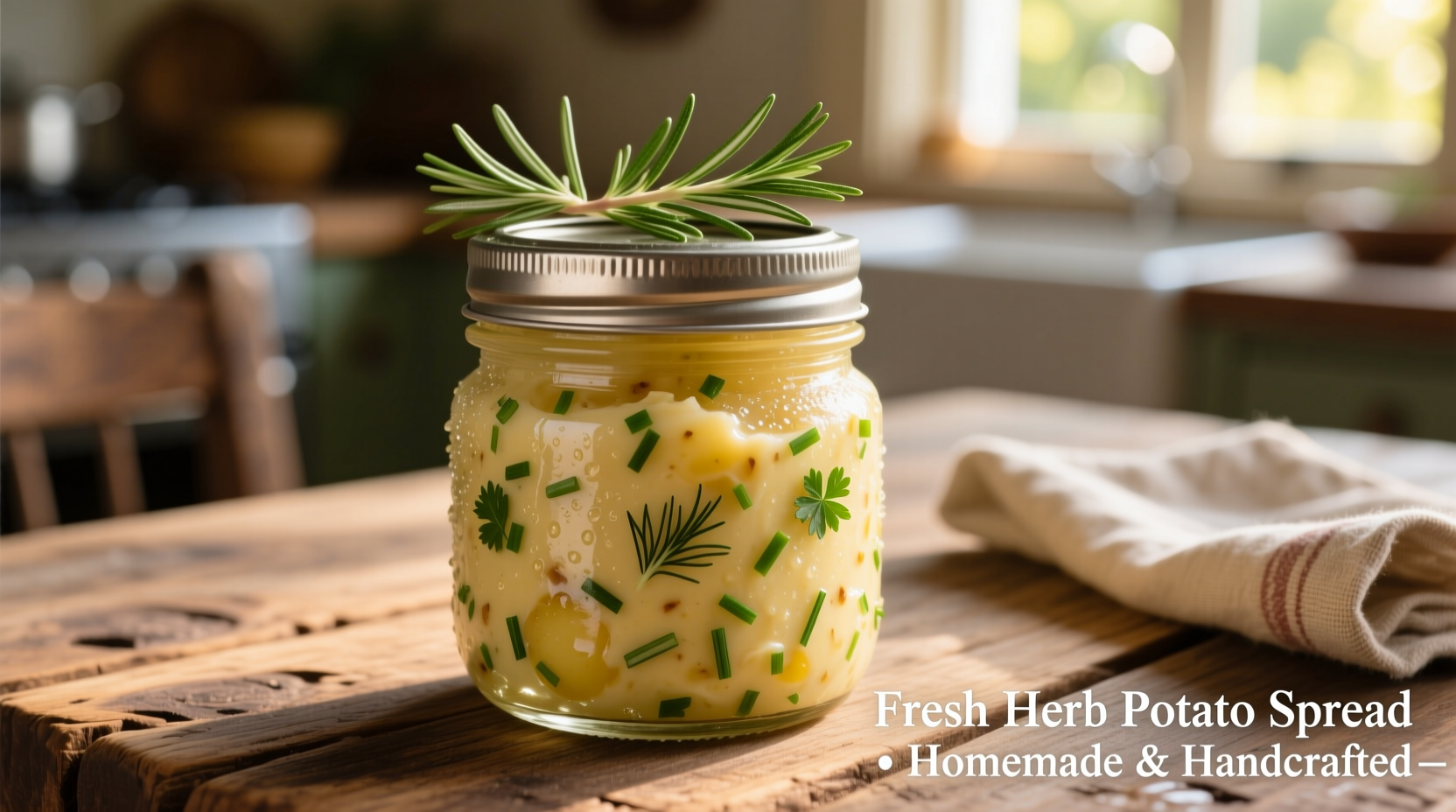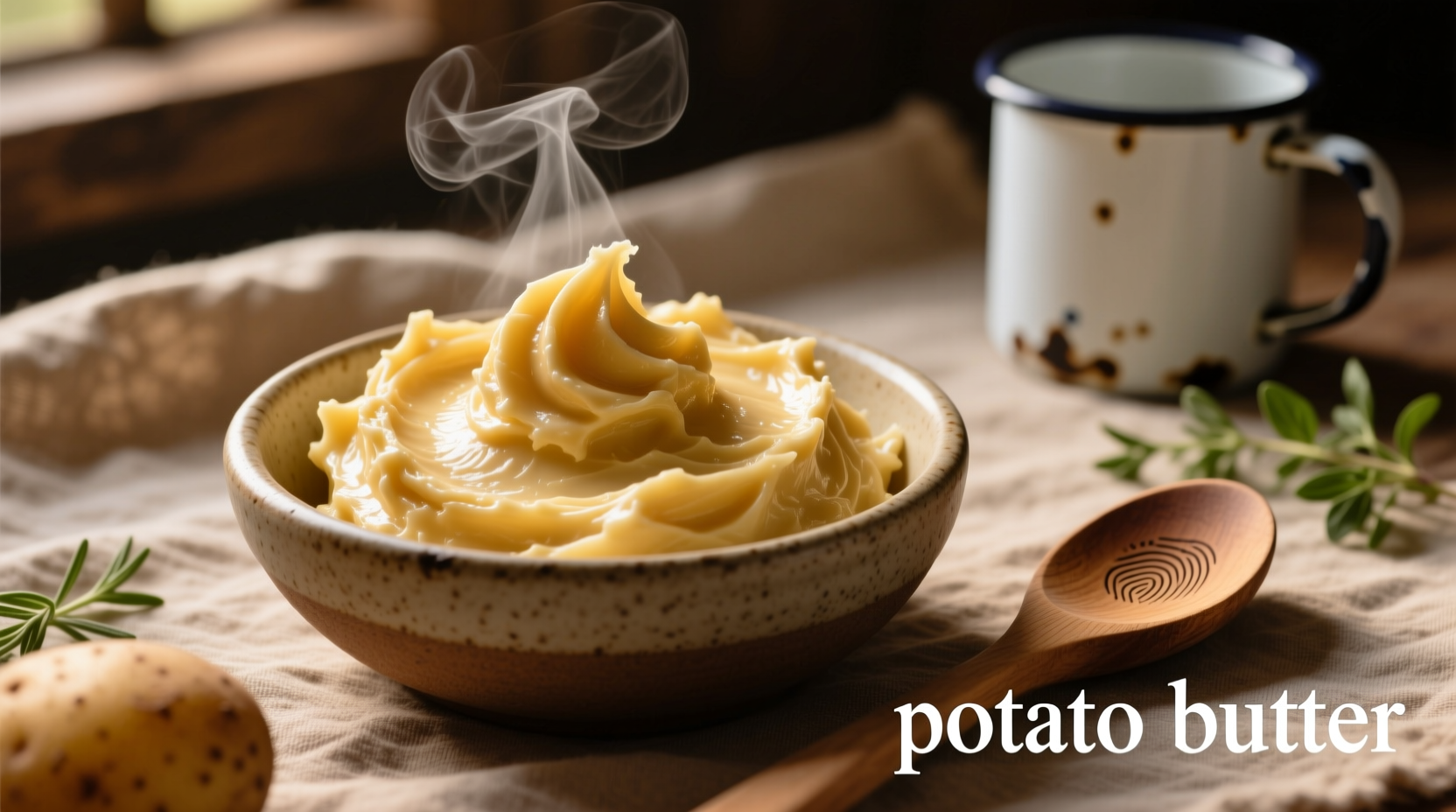"Potato butter" isn't a standard culinary product like peanut butter—it refers to potato-based spreads used as dairy alternatives. These creamy preparations typically blend cooked potatoes with fats, seasonings, and liquids to create a spreadable consistency ideal for toast, sandwiches, or as a baking substitute in vegan cooking.
What Exactly Is Potato Butter? Setting the Record Straight
Despite the name suggesting a direct parallel to nut butters, potato butter doesn't exist as a commercial product category. The term generally describes potato-based spreads created by blending cooked potatoes with oils, plant-based fats, and flavorings. These preparations emerged primarily within vegan and dairy-free cooking communities as versatile alternatives to traditional butter.
Food historians note that potato-based spreads have roots in European peasant cooking traditions, where resourceful cooks developed ways to stretch limited dairy supplies. During periods of scarcity in 19th century Ireland and Eastern Europe, cooks would blend boiled potatoes with whatever fats were available—sometimes including small amounts of actual butter—to create a spreadable mixture that mimicked richer dairy products.
How Potato Spreads Actually Work: The Science Behind the Substitute
Potatoes contain natural starches that, when properly cooked and blended, create an emulsion capable of mimicking butter's texture. The key to successful potato-based spreads lies in:
- Starch activation—cooking potatoes until fully gelatinized
- Proper hydration—adding just enough liquid to achieve spreadable consistency
- Fat integration—blending with oils or vegan fats for richness
- Flavor balancing—using acids and seasonings to mimic dairy notes
| Characteristic | Potato Spread | Dairy Butter |
|---|---|---|
| Fat Content | 25-35% (from added oils) | 80% minimum |
| Water Content | 50-60% | 15-20% |
| Storage Life | 5-7 days refrigerated | 2-3 weeks refrigerated |
| Baking Performance | Good for moist cakes, less effective for flaky pastries | Ideal for all baking applications |
Practical Potato Spread Recipes You Can Make Today
Creating your own potato-based butter substitute takes just 15 minutes with basic kitchen equipment. Professional chefs recommend using starchy potato varieties like Russets or Yukon Golds for optimal texture.
Basic Potato Spread Recipe
This foundational recipe creates a neutral-flavored spread suitable for most applications:
- 2 cups cooked and cooled russet potatoes (peeled)
- ⅓ cup neutral oil (avocado or light olive oil)
- 2 tbsp nutritional yeast (for dairy-like flavor)
- 1 tsp lemon juice or apple cider vinegar
- ½ tsp salt
- 2-3 tbsp plant-based milk (as needed for consistency)
Method: Blend all ingredients in a food processor until completely smooth, scraping down sides as needed. Chill for at least 2 hours before use to allow flavors to meld and texture to firm up.
Flavor Variations for Specific Uses
Tailor your potato spread for different culinary applications:
- Garlic-Herb Spread: Add 2 roasted garlic cloves and 2 tbsp fresh herbs (rosemary, thyme, parsley)
- Sweet Cinnamon Spread: Omit nutritional yeast, add 2 tbsp maple syrup and 1 tsp cinnamon for toast
- Baking Blend: Increase oil to ½ cup and add 1 tsp apple cider vinegar for better emulsion in cakes

When Potato Spreads Shine (and When They Don't)
Understanding the context boundaries of potato-based spreads prevents kitchen disappointments. These alternatives excel in specific applications while falling short in others:
Ideal Applications
- Spread for hearty breads and sandwiches
- Moisture-rich cake recipes (carrot cake, banana bread)
- Sautéing vegetables at medium temperatures
- Base for creamy salad dressings
- Finishing touch for mashed potatoes (adds extra richness)
Limitations to Consider
- Not suitable for high-heat frying (smoke point around 325°F/163°C)
- Won't create flaky pastry layers like real butter
- Loses emulsion when frozen and thawed
- Shorter shelf life than commercial butter substitutes
- Distinct potato flavor may interfere with delicate desserts
Historical Evolution of Potato-Based Fats
The timeline of potato spreads reveals how necessity drives culinary innovation:
- 1840s: During Ireland's Great Famine, resourceful cooks blended boiled potatoes with minimal dairy to stretch scarce resources
- 1910s: Eastern European immigrants brought potato spread techniques to America as dairy alternatives
- 1970s: Vegan movement revived interest in potato-based fats as part of dairy-free cooking
- 2010s: Food science advancements improved emulsion techniques for better texture and shelf stability
- Present: Specialty food companies offer refined potato-based spreads focused on specific culinary applications
Nutritional Comparison: Potato Spread vs. Traditional Butter
For health-conscious cooks, understanding the nutritional profile matters. While not identical to butter, potato spreads offer distinct advantages:
- Lower saturated fat: Naturally contains less saturated fat than dairy butter
- Cholesterol-free: Contains no cholesterol, making it heart-healthier
- Higher potassium: Potatoes contribute significant potassium content
- Fiber content: Contains small amounts of dietary fiber absent in butter
- Vitamin profile: Provides vitamin C and B6 from potatoes
Registered dietitians note that while potato spreads offer nutritional benefits, they shouldn't be considered a "health food"—they remain calorie-dense preparations best used in moderation as part of balanced eating.
Common Misconceptions About Potato Butter
Several myths persist about this niche culinary preparation:
- Myth: Potato butter is a traditional product like peanut butter Reality: It's a modern culinary adaptation without commercial production history
- Myth: Potato spreads work identically to butter in all recipes Reality: They excel in specific applications but can't replicate butter's full functionality
- Myth: All potato spreads taste strongly of potatoes Reality: Properly made versions have subtle potato notes that blend with added flavors
- Myth: Potato spreads are always healthier than butter Reality: While lower in saturated fat, they remain high-calorie preparations requiring mindful use











 浙公网安备
33010002000092号
浙公网安备
33010002000092号 浙B2-20120091-4
浙B2-20120091-4